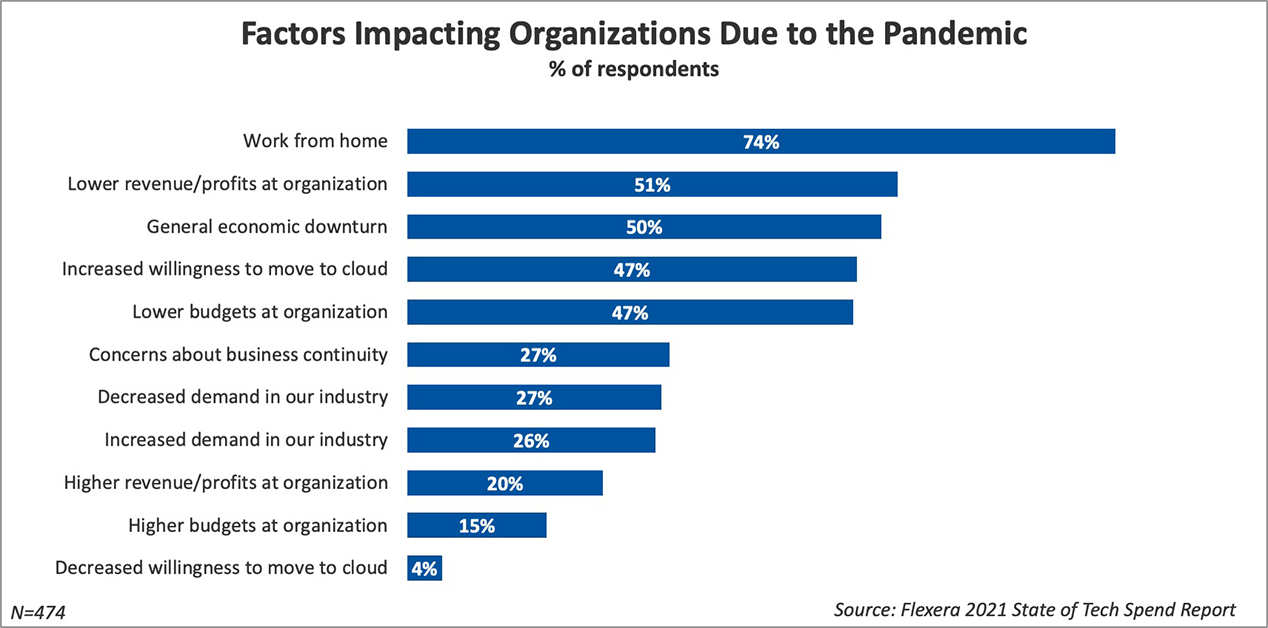According to a 2021 Flexera State of Tech Spend Report, the top three pandemic-related factors that impacted organizations were employees working from home, lower revenue and profits, and a general economic downturn.
For IT leaders, this means supplying a new remote, hybrid, or changed workforce with the hardware, software, and support necessary to continue business operations — all with decreasing overall budgets amid an unstable economic future.

With so much uncertainty, creating your 2022 IT budget might no longer be as simple as copying over last year’s. There’s a delicate balance of cutting enough to bring costs down, but not so much that the savings are overshadowed by service interruption and eventual inefficiencies.
When you sit down to build your budget strategy, start by separating it into a few categories: hardware, software, personnel, and processes. This will help you ensure you’re examining every area for possible budget reduction. Then, for each section of your budget review, ask yourself these questions to identify potential opportunities for IT budget reduction:
Are we only paying for what we need? Do we really need it?
Monthly software fees and annual licensing costs make budget projecting easy and consistent but can also cause us to pay for more than our organization needs. For example, ignoring a slight increase in email platform annual fees or an extra printer for a few key employees’ desks is easy. However, hidden in these small changes is the chance to cut costs in your 2022 IT budget. Consistent review of the recurring software fees and ongoing maintenance costs is the best way to ensure those costs don’t creep up year over year.
For your organization, the answer to these questions might sound like this: Our total number of employees has decreased, so we can negotiate moving into a lower-cost pricing tier for our email service. Or, we’re paying more per page for documents printed on devices in individual’s offices, so let’s eliminate those printers and route printing to multifunction devices.
Are we paying for duplicate services or hardware?
In fast-paced organizations, it’s common for individual departments to unknowingly create software and hardware redundancies that burden your budget. Are your product designers and marketing designers paying for separate Figma accounts? Could you make one enterprise account and pay a discounted rate with seats for all users? Does your HR team need their own printer, or can they use the multifunction device down the hall?

For IT leaders, this means avoiding budgeting from a bubble. Connect with leaders and employees around the organization to understand what they use and how you can help them work more efficiently and cost-effectively.
Can we move this to the cloud?
If you’re reading this, we know that you know that it’s time to move to the cloud. You might not know where to start. While undertaking the migration may seem like a significant initial time investment, the numbers support the long-term cost and efficiency benefits of a cloud-based IT infrastructure. Moving to the cloud will cost your organization less in the long run, require less maintenance, and is ideal for dispersed workforces.

In a study conducted by Rackspace and reported on CIO.com, 88 percent of cloud users pointed to cost savings, and 56 percent of respondents agreed that cloud services have helped them boost profits. These savings have helped companies increase headcount, invest in specialized talent, and launch new initiatives.
Does my team understand our department’s budget?
When an employee or a team goes over budget, it’s rarely malicious. Oftentimes, overspending is simply caused by a lack of awareness of the budgetary constraints of a project or department. Budget transparency shares the burden of budgeting and welcomes the collective creativity and oversight of all employees.

At imageOne, we practice Open Book Management and proactively train employees to understand business finance. imageOne team members understand the company’s income statements and balance sheets and could tell you our monthly coffee budget and even how much it costs every time they’re tempted to print something. Every employee is equipped with the knowledge and understanding to make smart financial decisions for the organization and spend its money as prudently as if it were their own.
Simply sitting employees down and discussing your department’s budget will create more conscientious and engaged employees.
Can we outsource this?
Knowing your team’s capabilities and your organization’s priorities can help identify where outsourced support can most benefit you and your budget. For example, when it comes to printers and copiers, is your team bogged down with PC Load Letter tickets?
.gif)
Print management is a top contender for outsourcing for the time, money, and headache managing printers costs your department. By consolidating your fleet of devices and helping identify efficiencies in your document management processes, a managed print services provider can help you save time and money and eliminate those printer tickets from your team’s queue.
As an IT leader, making a smart budget strategy isn’t just about finding line items to cut; it’s about understanding your organization, its employees and using technology to create a more efficient workplace.
Start by questioning your past budget strategies and challenging yourself and your leaders to think differently about how your department maximizes its time and resources.
The experts at imageOne spend their days helping reduce IT budgets and deliver an extraordinary experience. Reach out to our team for help creating a cost-effective and efficient 2022 IT budget.
As we look toward 2022, the uncertainty brought about by the pandemic still looms, especially when it comes to budget planning and projections. Connect with me on Twitter and LinkedIn and keep up with my company imageOne. Check out my website or some of my other work here.




